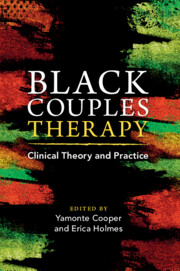Book contents
- Black Couples Therapy
- Black Couples Therapy
- Copyright page
- Contents
- Figures
- Tables
- Contributors
- Foreword
- Acknowledgments
- Introduction
- Part I Race, Racism, and Identity
- Part II Foundations for Healthy Coupling
- Part III Adapting Major Therapeutic Approaches for Work with African American Couples
- Chapter 6 Emotionally Focused Therapy with Black Couples
- Chapter 7 Use of the Gottman Method with African American Couples Impacted by Post-Traumatic Slave Syndrome
- Chapter 8 Transcending the Binary: A Narrative Therapy Approach to Work with Black Trans Men Navigating Gender Transition with Romantic Partners
- Chapter 9 Imago Therapy and the African American Couple
- Chapter 10 African American Narratives of Trauma: An EMDR Approach to Tapping into the Strengths of Black Love
- Part IV Sex and Intimacy
- Part V Special Topics
- Index
- References
Chapter 8 - Transcending the Binary: A Narrative Therapy Approach to Work with Black Trans Men Navigating Gender Transition with Romantic Partners
from Part III - Adapting Major Therapeutic Approaches for Work with African American Couples
Published online by Cambridge University Press: 27 July 2023
- Black Couples Therapy
- Black Couples Therapy
- Copyright page
- Contents
- Figures
- Tables
- Contributors
- Foreword
- Acknowledgments
- Introduction
- Part I Race, Racism, and Identity
- Part II Foundations for Healthy Coupling
- Part III Adapting Major Therapeutic Approaches for Work with African American Couples
- Chapter 6 Emotionally Focused Therapy with Black Couples
- Chapter 7 Use of the Gottman Method with African American Couples Impacted by Post-Traumatic Slave Syndrome
- Chapter 8 Transcending the Binary: A Narrative Therapy Approach to Work with Black Trans Men Navigating Gender Transition with Romantic Partners
- Chapter 9 Imago Therapy and the African American Couple
- Chapter 10 African American Narratives of Trauma: An EMDR Approach to Tapping into the Strengths of Black Love
- Part IV Sex and Intimacy
- Part V Special Topics
- Index
- References
Summary
This chapter addresses the challenges that often arise for Black transgender men and romantic partners when seeking support in therapy. It covers key terminology related to gender identity and its application to clinical practice with Black transgender men and their romantic partners. To further understand how to navigate couples therapy with transgender men, this chapter provides details on how to differentiate between gender and other facets of identity, like biological sex, gender identity, gender expression, gender presentation, and sexual orientation. The chapter also summarizes major Narrative Therapy concepts and explores Narrative Therapy interventions for working with Black transgender men and their romantic partners. A case example will serve as an education tool to illustrate Narrative Therapy with Black transgender men and their romantic partners.
- Type
- Chapter
- Information
- Black Couples TherapyClinical Theory and Practice, pp. 193 - 212Publisher: Cambridge University PressPrint publication year: 2023



